Magic: The Gathering has recently entered a fifth stage of design in which block design integrates flavor from the start and mechanical foci are just tools with which to build a broader experience.
Under this new model, we’re unlikely to see anything that’s as much a tribal block as Lorwyn, and that’s for the best. Over the years, Magic has had a lot of great expansions, but they’ve relied, to a certain degree, on luck. As much as we’d like our card designs to speak for themselves, they don’t. The flavor tied up in names, artwork, and flavor text need to feel natural to the card. And no matter how good your creative team, you’ll be able to accomplish that goal better by designing a card top-down. But let’s be careful not to conflate terms. Fifth stage design isn’t exactly building more flavor into the card designs; Scars of Mirrodin has very few top down cards, but it is a paragon of this new fifth stage.
The important shift, then, is tapping into human emotions not just through individual cards, but through the broader design of the actual block. In Scars, we got roughly 18% Phyrexian cards and 82% Mirran ones, Mirrodin Besieged had an even split, and in New Phyrexia, the victors dominated 86% to 14%. Even if a player never bothered to look for shifts, these numerical changes undoubtedly left them with an impression of Phyrexia’s takeover. Even outside of the sets, Wizards brought the war to the player base by making people choose a side in the Mirrodin Besieged prerelease and Game Day events. Even someone who’d never read a word of the storyline knew that the Mirrans and Phyrexians were at war, and moreover, they probably cared who won.

We can see more of the same in Innistrad block. Not only do we see the humans’ numbers dwindling in Dark Ascension, but a theme of Human sacrifice leaves an even more gruesome image than having all of the block’s art depict scenes from a victim’s eye view. For the Avacyn Restored prerelease, stores are even going to have their own Helvaults to crack open!
A Step Back
By now, it should be obvious that I’m a big supporter of R&D’s most recent shift, but as Magic designers, it would be a tragedy if we took this improvement to mean we should ignore all that came before it. Just as Aaron Forsythe looked to Alpha in hopes of understanding how Magic 2010 and its descendants ought to work, we’re going to look back at Magic’s fourth stage of design, the progenitor of blocks Ravnica: City of Guilds through Zendikar.
Since Invasion, blocks have been based on a bottom-up mechanical theme. We’ve seen multicolored and tribal, graveyard and artifacts, lands, and even time. What we haven’t seen—and now never will in quite the same way—is enchantments. Yes, Urza's block had an enchantment theme, but between a lack of mechanical focus amidst the cards and some rather unfortunate naming (the books about Urza’s early career are The Artifacts Cycle), it was never appreciated as such.
Last week, you voted to see another method of world building in action, and now we’re going to see how I imagine Wizards of the Coast did most of their plane design from the old Mirrodin up until the new one. Each of these blocks is focused on a singular mechanical element and exists in a world that supports it. Mirrodin was perhaps an obvious start. Where do you put a block about artifacts? Why not on a world made of metal? Need Alara’s three-colored factions not to interact? Break the world into five pieces. Where can lands matter? In a world where nobody has ever taken an arrow in the knee. The question we need to ask when building a world for this hypothetical enchantment block is: What exactly is an enchantment?
An Aura of Confidence
On the surface, an enchantment is nothing more than a permanent sorcery. Glorious Anthem is a Virtuous Charge, and Feast of the Unicorn is a Howling Fury. But in order to build a world around a mechanic, we need to figure out what it means to be enchanted. Is an enchantment the blessing of a deity? The protective wards that surround members of an aristocracy? Equipment for battle? Any of these flavors, or almost any other, could work as the basis for a world. My one inclination would be to shy away from the personal enhancements angle since it’s awfully reminiscent of what it meant to be an artifact on Esper; but really, the important things is to pick one and run with it.
But before making a decision at random, we’d be well served to remember that this setting is meant to support mechanics, and while global enchantments are fine, Auras have historically been very weak because they are so easily turned into card disadvantage. We’ve seen a number of attempts to fix the problem over the years: Carapace, Rancor, Frog Tongue, Briar Shield, Elephant Guide, Dragon Fangs, Fists of Ironwood, Boar Umbra, and most recently, Angelic Destiny all chronicle attempts to make Auras worthwhile. But while some of these have seen Constructed play, none of these fixes has made for a generally passable subtype.
I’m sure efforts at Wizards are ongoing, and Goblin Artisans had the discussion going on just last month. A “perfect” fix would involve stopping the two-for-ones both when the Aura is on the stack and after it resolves, but fixing the whole problem might not be the best approach. I’d wager that the majority of less experienced players underestimate Auras’ weaknesses even if those players are aware of them, and we certainly don’t want to go printing unexciting enchantments just to balance them. Our real goal should be to solve just enough of Auras’ issues to make them worth the risk while still doing exciting things.
The Saga Begins
Our first option is to use the Rancor or Angelic Destiny template. This still leaves Auras vulnerable on the stack, and it has the additional issue of being ineffective on expensive Auras because the tempo loss will still beat you even if card disadvantage doesn’t. This ability, especially in its more recent form, lends itself to being flavored as inheritance. Perhaps Auras could be titles, like this:
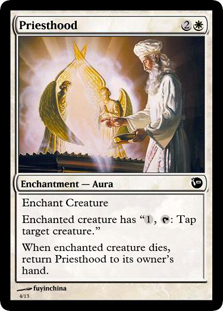
Riffing off this family-based society, we could build multiple clans into the world and then somehow set them into conflict. Maybe there’s some sort ultimate position of authority, and its previous tenant died without progeny:
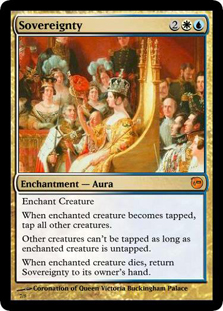
Without a monarch, the protective wards (global enchantments) that protect this enclave begin to crumble, and beings of pure magic wreak havoc in the streets.
Pole Vaulting
Then again, totem armor seemed to work pretty passably in Rise of the Eldrazi, so perhaps we don’t need to make Auras that recur themselves. Totem armor could be flavored the same way it was in Rise, but we could also go for a less tangible sense of learning from history:

This flavor might lead toward Native American creation myths, in which case we can either have people who’ve learned these stories or even have the animal figures themselves. One possible story would be reminiscent of Kamigawa, with the sentient races of the plane coming into conflict with their canonized forbearers.
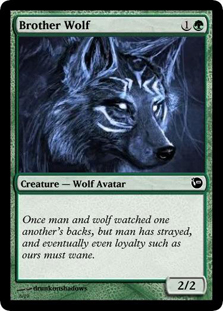
Perhaps these Avatars would bring mechanics to punish un-enchanted creatures (those who’ve forgotten the past); a few Brainspoils go a long way toward making Auras worthwhile.
Locked On
The final preexisting mechanic I want to look at has never been printed on a Magic card, but it comes rather from the aforementioned Goblin Artisans post.
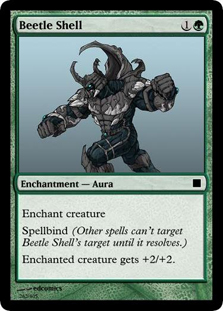
This solution would work really well as protections granted to an upper class—especially because, by its nature, this mechanic wants to go on protective Auras to make itself relevant. If we decided to go with Jay’s second option of folding it into a new form of the enchant keyword, it could even bring class struggle to the players. The rich even get a better way to enchant creatures!
What ignited enough action for us to visit this plane? An economic meltdown, perhaps, or the discovery of a means for immortality.
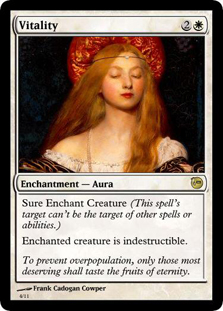
Either way, the masses would rely on numbers (swarming and tokens) while the elite would work to build a few champions (by piling boon Auras upon them). As in the creation myth setting, we could include Brainspoil-style effects, this time in the guise of diseases that only the wealthy can afford to have treated.
One Way Aura ’Nother
Obviously, none of these settings is as thoroughly explored as the Western one we just left. I was trying to show—rather than tell—how one might go about building a story and a setting from a mechanical implementation, and I’m not quite sure I succeeded. Do you want a different explanation of world crafting from a mechanical base, or do you just want to dive into one of the ones before us? (Note that the mechanics aren’t necessarily tied to the worlds they spawned):
[poll id=”138”]
Jules Robins
julesdrobins at gmail dot com
























